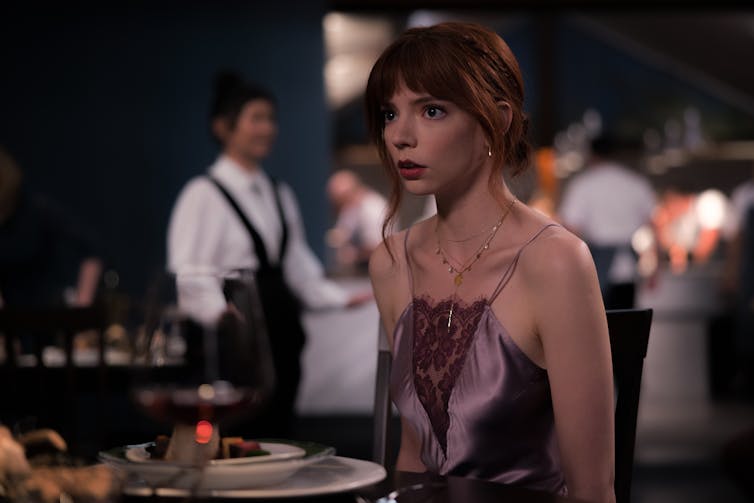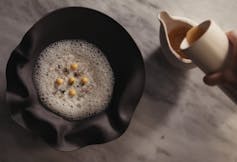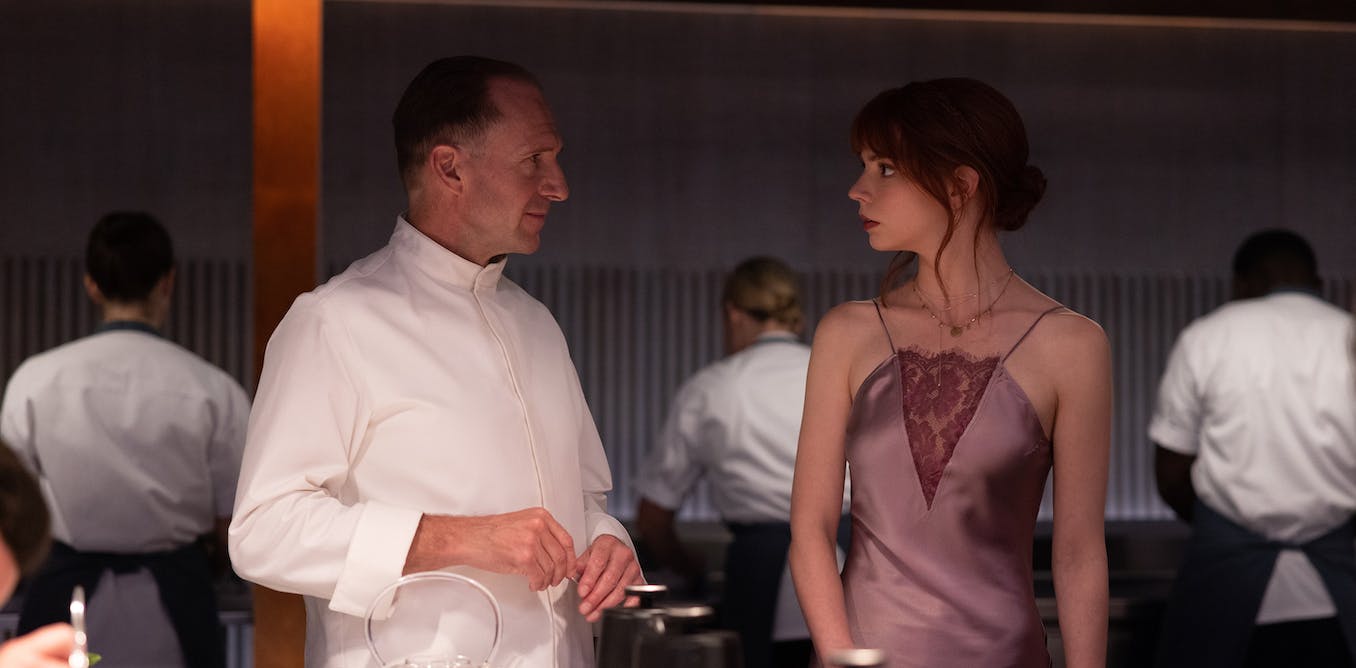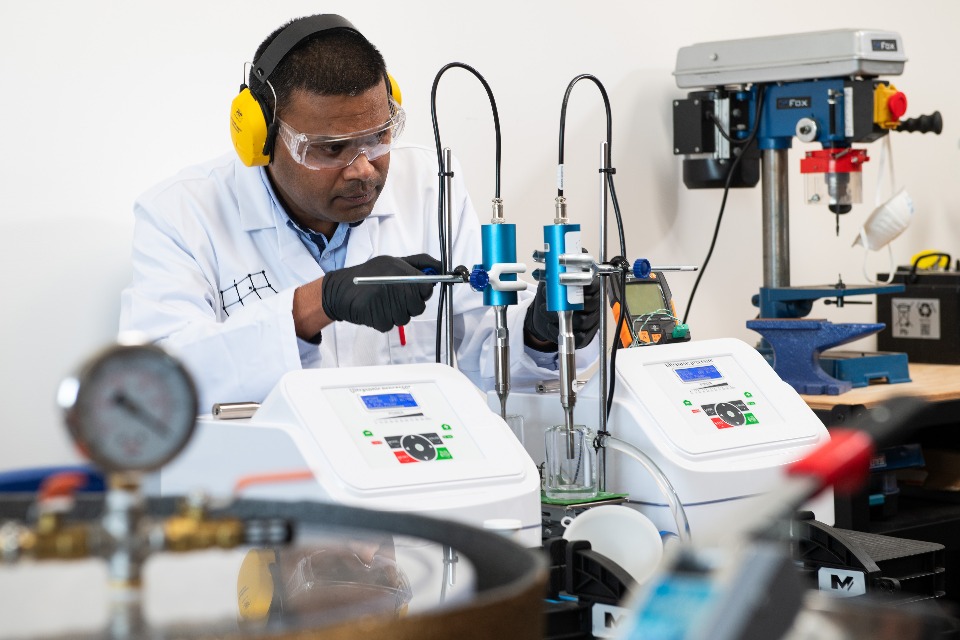This story contains spoilers about ‘The Menu.’
The Disney+ release of horror/comedy The Menu marks the beginning of what is already shaping up to be a reckoning year for the world of fine dining.
The film, released this past fall, is directed by Mark Mylod, known for producing and directing the acclaimed series Succession, and satirizes the culture of high-end dining.
From the perspective of our combined expertise in food and literary studies and sexuality studies, we’re interested in how the film asks us to consider what’s left when even the most fundamental bodily pleasures are turned into commodities: things that can be marketed, bought and sold.
Gory confrontation
The Menu depicts a gory confrontation between overworked restaurant workers and elite diners at the exclusive and remote restaurant, Hawthorn. The restaurant is presided over by its celebrated executive chef, Julian Slowik (Ralph Fiennes).
Reviews of The Menu often focus on Hawthorn’s wealthy customers swooning over food, its highly trained and obedient staff or its meticulously and madly murderous chef.
While these characters are compelling, they are also parodies. The most extreme example of this is foodie Tyler (Nicholas Hoult), who is so desperate to experience the esteemed chef’s cooking that he goes to Hawthorn knowing that he (and all the others) will die there.
While Tyler is absurdly entertaining, the film follows the perspective of protagonist Margot, who isn’t familiar with the world of haute cuisine.
Margot is not just important because viewers who don’t have much experience with fine dining culture, or who empathize with criticisms of it, can relate to her. Her perspective is also crucial to understanding the film’s interesting and complicated treatment of eating, labour and pleasure.
Pretentious techniques
From the beginning, Margot balks at the restaurant’s pretentiousness and avant-garde techniques, like gelification.
Viewers might identify with her eye rolls and impolite snickers, and may even do the same when, for example, a routine welcome speech delivered by the chef brings Tyler to tears.
These expressive responses from Margot add humour to the film and show the ridiculousness of Chef Julian’s plans for what he calls “the greatest menu ever created.”
Giving and taking
Unlike Hawthorn’s staff and regular diners, Margot doesn’t easily fit into the distinction the chef makes between “those who give” (service workers) and “those who take” (wealthy customers).
As we come to learn, Margot is also working while at Hawthorn: she is a sex worker hired by Tyler, even though he knows that it will mean her death.
Like the restaurant staff, Margot is subjected to the whims and desires of insufferable (and dangerous) clients like Tyler, who have no regard for the lives of the workers whose services they employ. At the same time, Margot is a customer of the restaurant. She is the sole character who is both serving and being served.

(Eric Zachanowich/Searchlight Pictures)
Eating and class status
Margot is also distinct because she does not treat food as an art object or a subject to master, nor does she eat to signal her class status. Her relationship to eating is a more carnal and tactile kind of intimacy. Margot is hungry, and she demands to be fed.
The Menu: Ralph Fiennes’s new film shows why restaurants are a ripe setting for horror
Others have pointed out how The Menu comments on labour conditions in the restaurant industry. This is certainly an important topic the film explores, and is especially relevant as restaurants reckon with long-standing concerns around industry sustainability that were sharply exposed during the COVID-19 pandemic.
For example, given these labour issues, there are questions about whether the fine dining industry should even exist in the future — questions that have become especially public with the recently announced closure of Noma, Copanhagen, named the “World’s Best Restaurant” in 2021.
Invested workers
However, Hawthorn’s staff is not only reducible to working-class warriors taking revenge on their oppressors. They, too, are invested in the culture of fine dining and insist on a similar kind of perfection as their diners.

(Eric Zachanowich/Searchlight Pictures)
In an absurdly hilarious and grim take on what fine dining has become, Hawthorn’s diners and staff perform their roles — serving and being served, cooking and eating — to their fiery (and gelatinous) deaths.
Margot understands the pleasures that have been stripped from both cooking and eating.
In a scene where Chef Julian asks Margot if she enjoys her work, she says she used to, but no longer does. Even so, unlike some of the others, she clearly still has a strong appetite for life and living.
Hungering for pleasure
By asking Chef Julian to make her a cheeseburger (because she’s “still fucking hungry”), Margot both leverages her position as a customer and reminds him of the pleasure of cooking a meal that someone genuinely wants to eat.
She’s the only character who actually fights for her life. It is because of these desires (to live and enjoy life) that she is the only person to leave Hawthorn alive, a delicious and fulfilling takeaway cheeseburger in tow.
Although the idea of being trapped on an island at the mercy of people skilled with butcher’s knives is a frightening thought, The Menu’s real horror comes from the ways food, eating, and cooking lose their carnal pleasures under capitalism.




